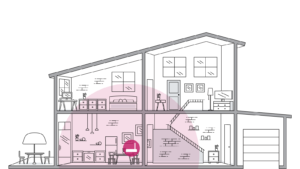Hi, Geeks! This month we’re looking at mesh networks. Specifically, what it is, and why it’s such an incredible solution for all sorts of Wi-Fi issues.
We’ve come a long way from the days of dial-up and extremely slow internet speeds. However, modern Wi-Fi isn’t without its drawbacks. Many of us deal with ‘weak’ spots in our home and workplaces, or struggle to connect when the router is behind a concrete wall. These problems are common, but with a mesh network, they don’t have to be.


Traditional WiFi vs. Mesh WiFi
What is a mesh network?
A Mesh network is a different approach to a Wi-Fi system. Instead of a single modem, a mesh network involves multiple Wi-Fi sources, each called ‘points’ or ‘nodes’. Therefore, instead of trying to find the best place for your router – but ultimately ending up with ‘weak’ spots at far ends of the home or in the garage – you place these points all around the home or office. This way, you are close to a Wi-Fi source no matter where you are, so you will always enjoy a strong signal.
Additionally, these points work together wirelessly. Just one of the points is physically connected to the modem, whereas the rest act as satellites. So when you move around the area, you’re always connected to the same signal, so there’s no lag when you switch from one point to another.
Mesh networks are not new. Large commercial units, such as hospitals and military facilities, have long used mesh networks for reliable connections. However, it is fairly new for residential uses, and for smaller businesses.
Traditional router & Range Entender
Mesh Wi-Fi Network (Brand: TP-Link Deco)
Why a mesh network can solve your Wi-Fi problems
If you’ve ever dealt with weak spots in your Wi-Fi at home or at work, a mesh network can help.
This solution is ideal for larger homes and workplaces where a traditional single modem is not enough to cover the entire area. It will ensure that you receive full-strength Wi-Fi no matter where you are, avoiding awkward lags and poor communication. You can even add extra points or nodes over time. If you find that your existing mesh network doesn’t cover enough area, it’s easy to add an extra point to cover that space. Should a point go down, you won’t even necessarily lose your Wi-Fi connection. Other points in your network will automatically pick up the slack, making mesh a system you can rely on.
Ultimately, a mesh network offers stronger, more reliable Wi-Fi connections, no matter the size of your property or the number of devices connected.
Geeks on Wheels recommends…
There are already a number of mesh network solutions available for purchase, which can make it tough to know which one offers the best service and value. Each have their own pros and cons. Some are designed for a large number of devices, others to cover larger homes.
At Geeks on Wheels, we recommend the TP-Link Deco ranges. They are easy to set up, feature a guest network, and some come with parental control. To find out more, book a Geek for tailored advice about the best option for your home.
